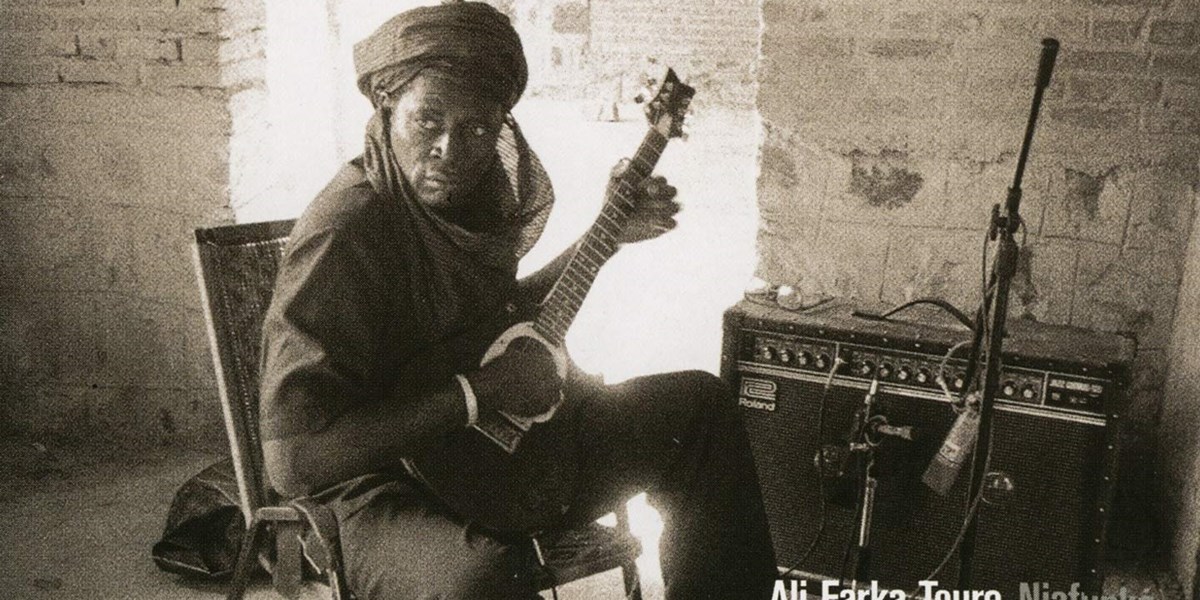Thursday, October 31, 2019
At home with Ali Farka Touré
To record Ali Farka Touré’s album 'Niafunké', World Circuit took a mobile studio all the way to Mali. Nigel Williamson went to meet Touré for Songlines in the summer of 1999 and found out why his commitments at home meant that the mountain had to go to Mohammed

Despite being one of the biggest names in world music, Ali Farka Touré insists he is not really a professional musician at all. 'I'm a farmer first. Music is very important to me but my profession is agriculture. I’ve got 11 children and I have to cultivate the land. Whenever I leave the village I feel I am shirking my responsibility.’ Touré’s village is Niafunké in Mali, a tiny rural settlement of some 2,000 people. It is also where his new album was recorded, a back-to-the-roots location that could not be in greater contrast to the state-of-the-art studio in Los Angeles where his last album, 1994’s Grammy award-winning Talking Timbuktu (World Circuit) was made with Ry Cooder.
To reach Niafunké involves a three-day journey up the Niger river from the capital Bamako by steamboat or an 18-hour drive across the Sahara on a desert track. Aware that Touré was increasingly reluctant to travel (he has ploughed all the money he makes from his albums back into cultivating and irrigating the land), World Circuit producer Nick Gold resigned himself to the fact that to get another album he was going to have to make a journey to Mali with a mobile recording studio.
He also took a generator (as Niafunké has no electricity), setting up a makeshift studio in an abandoned mud-brick building on the edge of the village, where Ali would come at nightfall after the crops had been tended and the day's work done. ‘You had to make sure you got it down because he is a one-take man,’ says Gold. ‘It was done very organically and fast.’ In the end he returned with a dozen tracks, all new compositions but steeped in the West African tradition and sung in different local tribal languages including Peul, Dogon, Tamaschek and Songhai.
There are songs about moving the cattle to new pastures and songs urging African parents to send their children to school. The sound and instrumentation is spare but intense - just Touré on guitars and the single-string njarka fiddle, the guitar of his long-standing accompanist Affel Bocoum and percussion of calabash, bongos and djembe, without any studio trickery. ‘It is more authentic because it was recorded in the place where the music belongs,’ Touré says. ‘We were in the middle of the landscape where the music comes from and that in turn inspired me and the other musicians. I don’t feel as good anywhere else as I do at home, which is why I think this is a better album than Talking Timbuktu.'
Sixty this year, Touré is not a griot – the ancient caste of professional West African singers and story-tellers – but in 1949 he started playing the single-string West African guitar (sometimes known as a monochord). He took up the Western guitar in the mid-1950s, adapting it to his own unique style. ‘No one ever taught me to play. I transposed what I knew from our one-string instrument onto a six-string guitar and I tuned it according to my ear. I know all the Western tunings but they are no good to me at all.'
He later worked as a sound engineer, spending several years at Radio Mali in Bamako, and began recording for the French label Son Afrique in 1974. He made six albums for them, but the experience was an unhappy one as he was not paid and he returned to Niafunké and the agricultural life in 1980, disillusioned with making music, only to be tempted back by World Circuit's Ann Hunt, who travelled to Mali to find him in the mid-1980s. She finally made contact with him after Radio Mali put out a message asking him to get in touch as a white woman from England had come to see him. 'It must have been God’s will, ' he says today.
World Circuit brought him to Britain for the first time in 1987, and he has now recorded five albums for the label, characterized by a number of interesting collaborations. The River in 1990 included Irish musicians Sean Keene and Kevin Conneff from The Chieftains, and a year later The Source featured Nitin Sawhney. But it was the appearance of the American bluesman Taj Mahal on that album that created the greatest stir, for there is an uncanny bond between Touré's African guitar and the brooding work of such Mississippi bluesmen as Robert Johnson and John Lee Hooker. The first time I ever heard John Lee Hooker was in 1978 and I instantly recognized the music,' he says. ‘ I knew where it had come from – even if he didn't. I taught Taj Mahal about Africa and I’d love to bring John Lee Hooker to Mali too so he could see where the music comes from. But he's too old to travel.’
Then came the collaboration with Ry Cooder. ‘I’ve never been so convinced by another artist,’ Touré says. ‘I’m trying to get him to come to Timbuktu for the New Year. I want to stage an African-American concert to see in the millennium, with me and B.B. King and Carlos Santana. That would be something. People call my music the Africa blues. I just call it the music of the people.'
This article originally appeared in Songlines summer/autumn issue 1999. To explore the full Songlines archive digitally, become a digital subscriber today!

